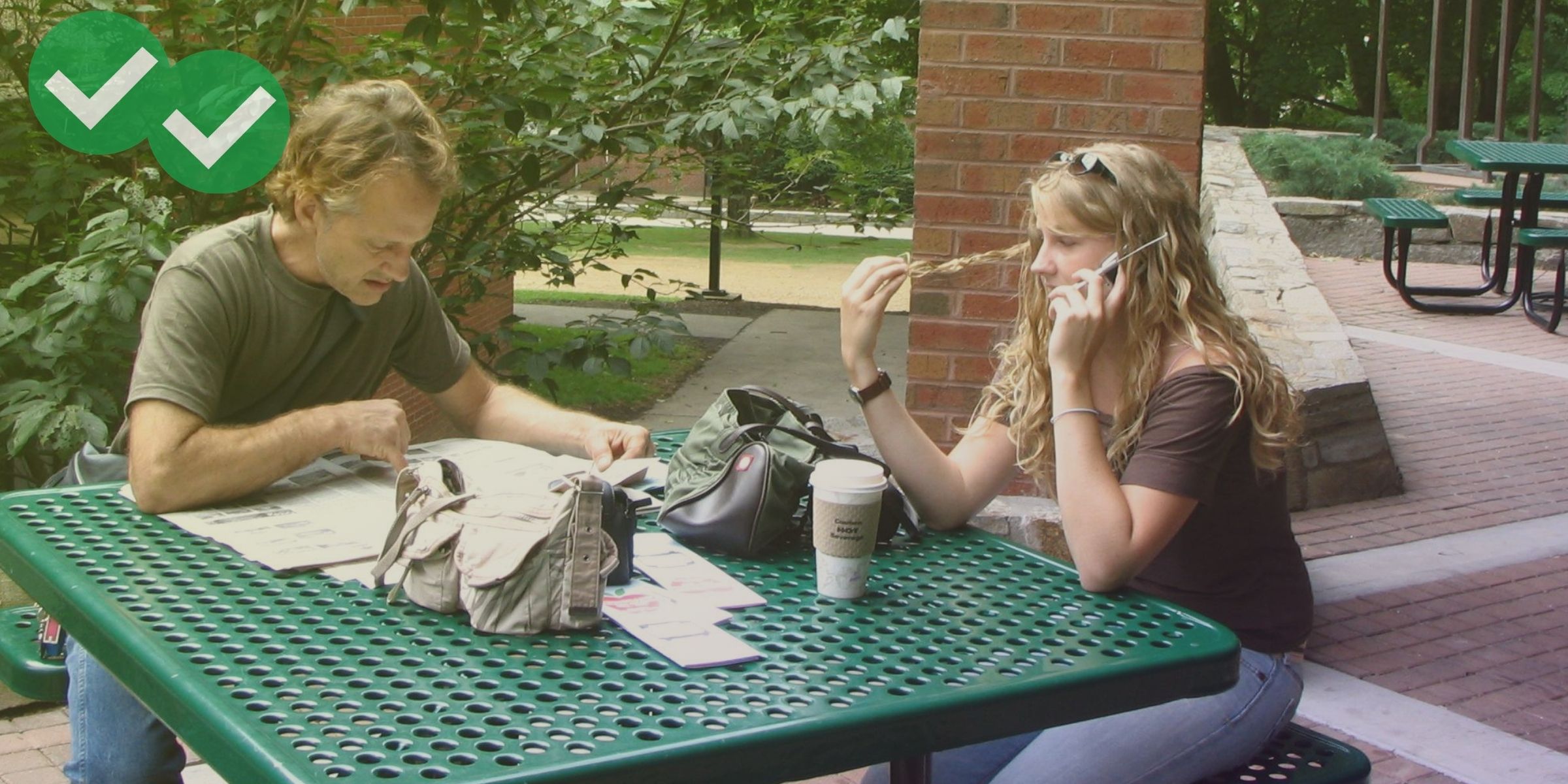
TOEFL Speaking Task 3 (the second Integrated Speaking task) is based on a combination of a reading passage and an audio lecture. Almost any subject that can appear in the Listening section lectures (or in the Reading section) may also be used for Speaking Task 3; common topics include literature, business, psychology, meteorology, and biology. All topics are covered at a beginner level; you won’t need any prior knowledge of these academic topics in order to do well on this question type in the Speaking section of the TOEFL.
The reading passage for Speaking Task 3 will be the same range of length as the passage for Task 2; you will have 45 or 50 seconds to read it, depending on the passage length. It will introduce a topic, often by defining a key term or idea with general descriptions. You can (and should) take notes as you read. Write down the key concept of the passage, and then touch on the main points that the passage makes. You can label these as the first reason, the second reason, and so on. Generally speaking, this information will only be necessary to provide background for your summary of the lecture; lecture-based Integrated Speaking questions do not ask you to discuss the reading passage in detail, because there is much more information in the lecture.
The speaker in the recording for Speaking Task 3 will always be a professor (and a native speaker of English). S/he will elaborate on the topic found in the reading passage, by adding more details and giving specific examples that illustrate the information found in the passage.
Then you will need to talk in detail about how the lecture explains the ideas described in the text. You will need to use reasons from both prompts to respond. Good, detailed notes will be crucial to answering this kind of question fully, so it’s important that you strengthen your note-taking skills by doing lots of practice! You cannot rely on the reading to give you your answer; you need to remember the specific details that were given in the lecture. Basically, you will summarize first the general idea in the reading, then the details in the lecture.
You will have thirty seconds to prepare your response, time that you should use to jot down the major points you want to make, and to draw any necessary connections between the reading and the passage. Then you will speak for sixty seconds. Answer the question in enough detail and in such a way that someone who had not read the passage or heard the lecture could make sense of your response.
Addressing TOEFL Speaking Task 3
What’s the best way for a test taker to answer Task 3 on test day? For these types of questions, a strong response starts with paying attention to the short passage. You must look for the key academic concept at the beginning of the reading, and then look for two supporting details or examples of the concept. Knowing this before you see the passage allows you to read the passage more quickly and confidently. And in the lecture, you don’t have to worry too much about what information is important in the listening passages. You can know that exactly two pieces of spoken information will be important — two illustrative examples related to the main idea of the passage.
TOEFL Speaking Task 3 Practice
Let’s practice reading and listening for the right details in Speaking Task 3 — the ones that are key to the task’s predictable structure. To do this, go to ETS’s TOEFL Quick Prep Volume 2 PDF and read the Speaking Task 3 passage found on page 29. Immediately after the passage, you’ll see a transcript of a Task 3 lecture. But don’t read the transcript. Instead, listen to the audio version of the lecture that I have created and linked below. (NOTE: TOEFL Quick Prep is slightly out of date, as the TOEFL Speaking Task list has been shortened and re-numbered since the Quick Prep materials were created. As a result, Task 3 on the current TOEFL is listed as Task 4 in the Quick Prep PDF.)
TOEFL Speaking Task 3: Audio
Once you’ve read the passage on page 29 of the PDF I linked above, listen to the audio for this task. Click the file below to play the audio. (Audio clip will open in a separate window.)
The Key Points from the Passage and Lecture
Hopefully, you were able to use your knowledge of the TOEFL Speaking Task 3 structure to easily identify the important ideas in both the passage and the lecture. To check your work, read through the answer key below. This key tells you the most important ideas in the prompt.
The Passage:
- Key academic concept: revealing coloration as a way for animals to defend themselves from predators
- Two supporting details: animals usually hide their bright colors; bright colors are revealed to startle or scare predators
The Lecture:
- Example 1: peanut bug surprises predator with bright colors
- Example 2: morpho butterfly blinds predator with reflected light
Improving Your TOEFL iBT Speaking Task 3 Response
How’d your Speaking section practice go? If you’re like a lot of test-takers, you may have found it strange to use details from both the reading and lecture, while focusing on your language use, in such a short amount of time. But with practice, you can improve your TOEFL test Speaking score on this task! Let’s take a look at how, using a transcript of a recorded TOEFL sample answer from a real Magoosh student! The student gave me permission to share the original response and the revision here on the blog. The task for this response comes from Test 3 in Official TOEFL iBT Tests, Volume 1.)
Carefully read the two versions of the Speaking Task 3 transcript below. What changes were made to the original response? Why do you think these changes were made? Based on these changes, what can you learn about TOEFL Integrated Speaking and effective use of English?
Speaking Task 3 Sample Response: First Version
The reading defines the term of (the concept of) implicit memory as a non-conscious method of memorizing. It means that our brain memorizes the events around us without our permission.
The speaker illustrates this point with an example. He said that in a test we install a billboard in a busy highway. Our billboard shows a car picture and its name which was Panther. Then, we ask the driver who commute in that highway if you notice that. Majority of them said no. But then we ask them what is the name of an animal which start with the letter P, majority of drivers said panther. This example clearly shows the unconscious method of memorizing.
Speaking Task 3 Sample Response: Revised Version
The passage defines “implicit memory” as an unconscious way to memorize something. In the process, our brain recalls things without any conscious knowledge.
The speaker illustrates this concept with an interesting example. There was a psychological test where a billboard was put on a busy highway. The billboard showed a picture of a brand name car called the Panther. After they drove the highway, commuters were asked if they remembered the billboard ad. Some commuters said they didn’t remember seeing that. But when these commuters were asked to name an animal starting with the letter P, the majority of them said “panther.” This example clearly shows implicit memory at work, because the drivers could remember the panther even if they didn’t consciously remember the billboard.
TOEFL Speaking Task 3: Mock Test
Ready to try practicing this task for yourself? Try this sample Task 3 prompt direct from the Magoosh product! Be sure to give yourself the same preparation time (30 seconds) and response time (60 seconds) that you’ll receive on a real TOEFL.
You will now read a short passage and then listen to a talk on the same academic topic. You will then be asked a question about them. After you hear the question, you will have 30 seconds to prepare your response and 60 seconds to speak.
First, read the the sample Task 3 passage here
Then, listen to the sample Task 3 lecture here
Finally, give a spoken response, following these instructions:
Using examples from the talk, explain how pictographs changed to become modern writing.
- Preparation time: 30 seconds
- Response time: 60 seconds
You can use a timer on your phone or an online timer (such as Google timer) to hold yourself to the time limits. And you can use your computer’s microphone or a web app such as Online Voice Recorder to record and save your response.
Then, when you’re done, check the video answer and explanation to see how you did.
Want even more TOEFL Speaking practice? Check out the ETS website for a sample Speaking set!
TOEFL Speaking Tips: Task 3 Takeaways
As with the entire TOEFL Speaking section, practice makes perfect for TOEFL Speaking Task 3! Unlike an Independent task, this Integrated task does NOT rely on your personal experience or opinions on a familiar topic. Instead, you’ll need to provide the important points and main reason(s) from the passage, then explaining how the lecture expands upon these ideas. A response that receives a high score will be descriptive, rather than opinionated. Good luck!







Leave a Reply